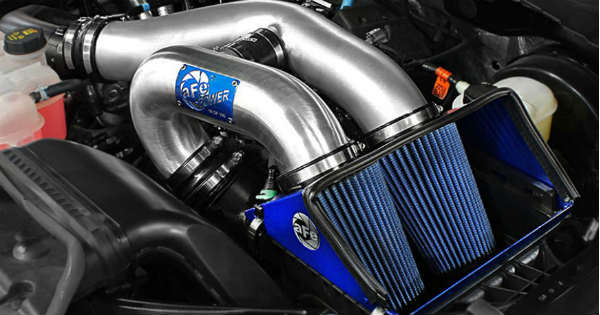If you own a car, then you should know about some great aftermath systems that make your vehicles more powerful. You can consider changing the exhaust system and making add-ons of turbos or superchargers. However, these tools cost a lot and are time-consuming. Installing these parts takes up a lot of time. But you can always implement a cold air intake to save both your time and money. It is fairly inexpensive (K&N intake prices approved) and will also help improve your vehicle’s performance.

Also, this valuable addition is easier to install than most other engine modifiers. Since the monumental transition, cold air intakes are continuing a great role in increasing the fuel economy. To help you understand, this article has pointed out the reasons for installing a cold air intake.
- Boosts in Acceleration: Pushing the acceleration paddle will give you satisfaction if your car has a cold air intake system installed in it. Manufacturers claim that a cold air intake can add up to 20 horsepower to your ride. Depending on your vehicle, the increased fuel efficiency may vary. If it is paired with other engine modifiers such as a new turbo or a new exhaust, the engine’s performance will be very efficient.
The engine’s responsiveness to acceleration is promptly sped up by inhaling cold air because the colder the air gets, the denser it becomes. Thus, additional air is supplied for combustion, taking your vehicle to the desired speed level quicker.
- Greater Fuel Economy: If both air and fuel are used to activate the engine, that can lead to an explosion that powers the vehicle. Vehicles try to compensate for the shortage of airflow by burning more fuel. Meanwhile, cold air intakes are more fuel-efficient than standard stock intakes.
So, add an aftermarket cold air intake to guarantee optimum air to fuel ratio. Not only does it play a role in the fuel economy enhancement, but it also reduces the gas expense as it improves the car’s gas mileage.
Therefore, the cold air intake system builds an interconnection between the system itself and mpg efficiency and enhances the performance of a vehicle.
- A Fiery, More Aggressive Sound: An aesthetic feature of getting to hear the magnificent sound of free air flow also comes with a cold air intake. If you relish the aggressive sounds of an engine, then opt for cold air intake. As there is a more intense flow of air, there is more throaty growl sound.
There are also options available in the market if you do not like the sound.
- Increases Airflow: A cold air intake will help your engine finally breathe even though it is not as powerful as other engine mods.
A cold air intake refills the engine combustion chamber with oxygen displacing the air filter outside the engine compartment. This generates power and allows the engine to run smoothly. Cold air intake keeps both air temperature at a minimum and increases airflow.
Blends are used at a minimum level which makes the space wider in cold air intakes. Also, smooth tubes with large diameters replace an airbox on the cold air intake, unlike other engine amplifiers, which helps them have an uninterrupted airflow.
- Longer Lasting, More Efficient Filters: Usually standard air intake vehicle systems are equipped with disposable paper filters that are used for catching debris. These stock intakes usually require replacement every 15, 000 miles.
To resolve these issues the aftermarket cold air intakes can be a solution. Unlike the typical stock intakes, aftermarket cold air intakes do not need to be replaced constantly. A cold air intake comes with air filters that last much longer as they only require cleaning within every 25,000 to 50,000 miles. You can wash this with soapy water and rinse it with cold water. It saves a lot of time and does not require any special tools or skills. In one word, cold air intakes are CONVENIENT!
Nothing But Upside
No real downsides have been pointed out about a cold air intake until now.
Some claim that it can lead to a damaged mass airflow sensor, but after some thorough tests, it was debunked by K&N.
Their website mentioned that dealerships have spread the urban myths about K&N filter oil can contaminate a vehicle’s MAF sensor. Unfortunately, no evidence had been disclosed to prove such a statement. On the other hand, K&N has proved the allegations to be wrong after years of diagnostic testing. They even proved that the claim is not even possible.
However, chances are that installing a high flow air filter replacing the original filter may disrupt your engine to suck up hot air instead, which will result in defective performance. This mainly could occur on turbo engines. So, planning out the design section is wise to avoid such situations. Plan out the layout that best suits your engine, and you can even attach a heat shield to keep hot air away within the engine bay.
With that said, if you own a vehicle or are a true car/truck enthusiast, do not hesitate while taking decisions about upgrading your car using a cold air intake. If you want extra acceleration, filtration, better engine efficiency, better visual appeal, better fuel economy, and an improving tone of the whole performance of your car, why wouldn’t you give cold air intakes a try?
Buying a car isn’t enough; upgrading the car’s performance and engine system is also important. The engine-enhancing technology is undoubtedly developing as the aftermarket companies are putting a lot of effort and investing millions to construct better cold air intakes. So, cold air intakes have undeniable benefits.
Warning: Installing a cold air intake in a new car could invalidate your car manufacturer’s warranty. Make sure you look into this matter before taking any steps!




